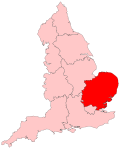| Sunshine Coast Line | |||
|---|---|---|---|
 | |||
 A Greater Anglia Class 360 departs Clacton-on-Sea in June 2013 | |||
| Overview | |||
| Status | Operational | ||
| Owner | Network Rail | ||
| Locale | East of England | ||
| Termini | |||
| Stations | 12 | ||
| Service | |||
| Type | Commuter rail | ||
| System | National Rail | ||
| Operator(s) | Greater Anglia | ||
| Depot(s) | Colchester Clacton-on-Sea | ||
| Rolling stock | Class 720 | ||
| Technical | |||
| Line length | 18 miles 4 chains (29.05 km) to Clacton-on-Sea 18 miles 43 chains (29.83 km) to Walton-on-the-Naze | ||
| Track gauge | 1,435 mm (4 ft 8+1⁄2 in) standard gauge | ||
| Electrification | 25 kV 50 Hz AC OHLE | ||
| |||
Sunshine Coast Line | ||||||||||||||||||||||||||||||||||||||||||||||||||||||||||||||||||||||||||||||||||||||||||||||||||||||||||||||||||||||||||||||||||||||||||||||||||||||||||||||||||||||||||||||||||||||||
|---|---|---|---|---|---|---|---|---|---|---|---|---|---|---|---|---|---|---|---|---|---|---|---|---|---|---|---|---|---|---|---|---|---|---|---|---|---|---|---|---|---|---|---|---|---|---|---|---|---|---|---|---|---|---|---|---|---|---|---|---|---|---|---|---|---|---|---|---|---|---|---|---|---|---|---|---|---|---|---|---|---|---|---|---|---|---|---|---|---|---|---|---|---|---|---|---|---|---|---|---|---|---|---|---|---|---|---|---|---|---|---|---|---|---|---|---|---|---|---|---|---|---|---|---|---|---|---|---|---|---|---|---|---|---|---|---|---|---|---|---|---|---|---|---|---|---|---|---|---|---|---|---|---|---|---|---|---|---|---|---|---|---|---|---|---|---|---|---|---|---|---|---|---|---|---|---|---|---|---|---|---|---|---|---|
| ||||||||||||||||||||||||||||||||||||||||||||||||||||||||||||||||||||||||||||||||||||||||||||||||||||||||||||||||||||||||||||||||||||||||||||||||||||||||||||||||||||||||||||||||||||||||
| ||||||||||||||||||||||||||||||||||||||||||||||||||||||||||||||||||||||||||||||||||||||||||||||||||||||||||||||||||||||||||||||||||||||||||||||||||||||||||||||||||||||||||||||||||||||||
The Sunshine Coast Line is the current marketing name of what originally was the Tendring Hundred Railway, a branch off the Great Eastern Main Line in the East of England. It links Colchester to the seaside resorts of Clacton-on-Sea and, via a branch, Walton-on-the-Naze. The line is part of the Network Rail Strategic Route 7, SRS 07.08, and is classified as a London & South East commuter line. [1] Passenger services on the line are currently operated by Greater Anglia.
Contents
Trains for Clacton-on-Sea usually originate at London Liverpool Street, while those for Walton-on-the-Naze typically start at Colchester (or Thorpe-le-Soken on Sundays). There are, however, limited morning and evening peak-time services in each direction between Walton-on-the-Naze and Liverpool Street.



